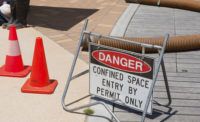Confined space training’s high stakes
A lack of knowledge can lead to loss of life

There’s hazcom training. Hearing conservation training. Any number of OSHA compliance training requirements. None have higher stakes than confined space training. And none may be more misunderstood.
You can’t underestimate the risks of confined spaces. Workers who don’t follow every safety procedure before entering a confined space put their lives on the line. And that certainly calls for effective training.
This article is by no means a complete description of OSHA’s confined space training requirements. For that, go to OSHA's website and read the confined space standard 1910.146. The intent here is to highlight some of the critical elements of confined space training.
Conduct a risk assessment
You may believe there are no confined spaces in your workplaces, and no need for any training. Perhaps. But be sure. We’re not only talking about tanks and silos. Potential confined spaces can include many crawl spaces, air handlers, duct-work, bag houses, utility vaults and tunnels, chimneys, large mixing vats, trash compactors, sump pits, large furnaces, sewer systems, drainage culverts and dock leveler pits. If the space is hard to get in and out of, and large enough to get your whole body inside, it’s probably a confined space. Again, check the standard for OSHA’s definition of a confined space.
Even if workers will never enter any permit-required confined space at your worksite, you still have one “training” requirement: you must notify all employees of the existence of your confined spaces and prohibitions against entering those spaces. Employees should know to look for posted danger signs at or near the entry point of each space and understand the spaces are off limits except for authorized personnel.
Cover the basics
Your confined space training should cover: 1) hazards associated with working in confined spaces; 2) basic responsibilities for entrants, attendants and supervisors; 3) recognizing and responding to hazards; and 4) rescuing entrants from a dangerous situation.
There are multiple kinds of confined spaces, and multiple hazards. These include: dangerously high levels of flammable gas, vapor, mist, dust or oxygen; high levels of toxic gas, vapor, mist or dust; low oxygen levels; liquids or flowing solids that can engulf and suffocate workers; entrapping design (such as a sloped roof); high heat that can cause exhaustion or heat stroke; power and equipment injury leading to shocks or electrocution; slippery floors or trip hazards; high noise levels; and unanticipated conditions that could put your life in danger.
Know the signs
The number one cause of death in confined spaces is too little oxygen in the air to breathe. Employees should know that signs of life-threatening low oxygen levels are shortness of breath, increased heart rate, dizziness, and impaired judgment.
Before starting work inside the space, an entry permit must be completed. No employee should ever enter a confined space unless their name is clearly marked on the permit. Only permitted workers – Entrants – may enter and work inside confined spaces. They must be trained to follow safety procedures including use of appropriate personal protective equipment and maintaining communication with the designated Attendant.
A final note: training designated rescuers in the event of an emergency is absolutely crucial. More than half of those injured in confined space accidents are rescuers.
Looking for a reprint of this article?
From high-res PDFs to custom plaques, order your copy today!






